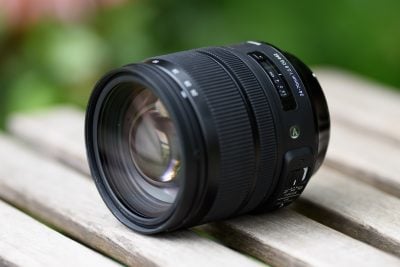Sigma 24-70mm f2.8 OS Art review
-
-
Written by Thomas
Quality
Longitudinal Chromatic Aberration and focus shift
With lenses offering a focal ratio of f2.8 or larger I test for longitudinal CA (loCA, a.k.a. “axial color” or “bokeh CA”). The new Sigma shows almost no coloration at f2.8 in the foreground (left) and only a little yellow cast in the background (right) which intensifies when stopped down to f4.0. But that’s nothing to worry about. And there is no focus shift to be seen at these shooting distances.
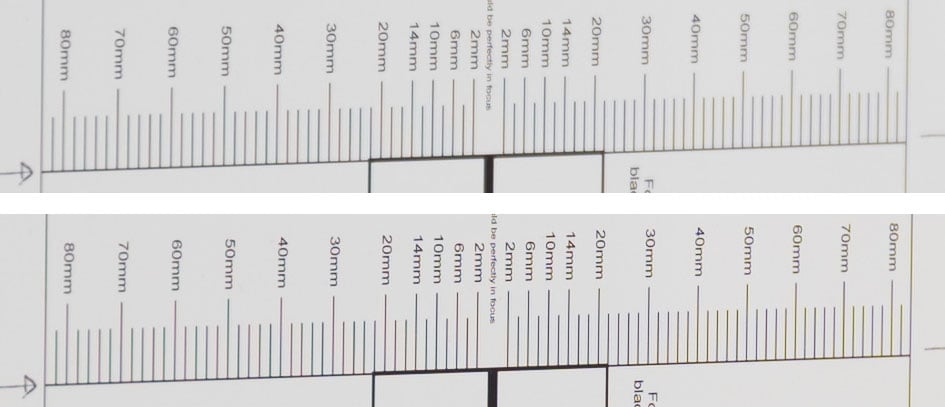
Above: Sigma 24-70/2.8 OS Art Longitudinal Chromatic Aberration (loCA). 100% crop, 70mm, 2.8 (top), f4.0 (bottom), left = foreground, right = background
The Nikon shows some magenta coloration in the foreground and a little green in the background:
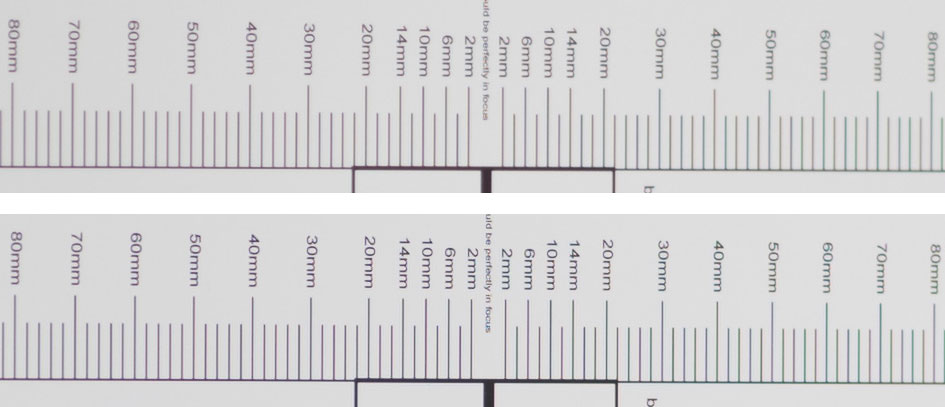
Above: Nikon 24-70/2.8E VR Longitudinal Chromatic Aberration (loCA). 100% crop, 70mm, f2.8 (top), f4.0 (bottom), left = foreground, right = background
Sharpness and contrast
Let’s have a look at the theoretical performance of the new Sigma first and compare it to the performance of the Nikon 24-70/2.8E VR:
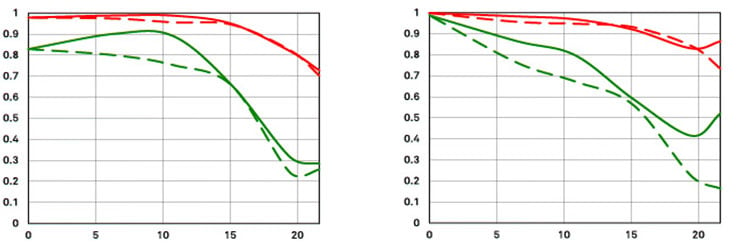
Above: MTF Sigma 24-70/2.8 OS Art at 24mm, f2.8 (left) and 70mm, f2.8 (right)
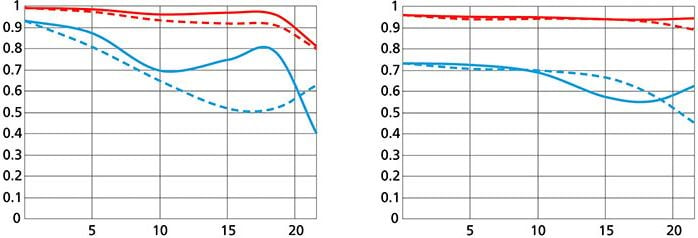
Above: MTF Nikon 24-70/2.8E VR at 24mm, f2.8 (left) and 70mm, f2.8 (right)
These charts show the lens-performance of both lenses at f2.8 without influence of diffraction. To read these charts you need to know that higher values are better and the closer the line-pairs are together the less astigmatism (= resolution depends on the orientation of the test-pattern) the lens has. The x-axis displays the distance from the optical axis (=center of the sensor) in mm. I’ll show you the real-life performance at 4 mm (center), 13 mm (APS-C/DX-corner), and 20 mm (FF/FX-corner) on a 36MP Nikon D810 body.
From the charts, overall contrast (red lines) from the new Sigma should be very high with a slightly stronger roll-off towards the FF-corner. The green 30 lp/mm line(s) also indicates a very good resolution of fine details from the new Sigma within the APS-C image-circle. There it looks even better than the Nikon especially on the long end but resolution drops pretty low in the FF-corner. Astigmatism seems pretty low. Let’s see how this theoretical performance translates into real life results in the sharpness test based on Siemens-stars.
What follows are near-center results (first column) followed by APS-C/DX-corner results and FF/FX-corner results on a D810. Processing was done in Lightroom 6.10 from RAW at Camera Standard settings. Noise-reduction is set to 0, sharpening to 35/0.5/36/10, with no extra tone, color, or saturation adjustment. In my comparative shots from the Tamron SP 24-70/2.8 VC below I set sharpening to 70/0.5/36/10 to compensate for the slightly softening effect of the AA-filter of the D800 which was used with the Tamron.
White-balance was adjusted to a neutral white and I did some exposure compensation to make the brightness of all crops match. So you will not see light fall-off in the corners. Removal of lateral color aberrations is ON, longitudinal CA are not corrected.
The following are all 100% crops!
First up is an overview of the wide-open performance at different focal lengths. You can jump to the detailed results at different apertures and comparisons with other lenses by clicking on the crops of the respective focal length. Except for 28mm because the results were not so much different from 24mm or 35mm.
Sigma 24-70/2.8 OS Art; 100% crop from center, APS-C/DX-corner, FF/FX-corner

Above: 24mm, f2.8

Above: 28mm, f2.8

Above: 35mm, f2.8

Above: 50mm, f2.8

Above: 70mm, f2.8
Sigma’s new lens is sharp in the center throughout the zoom-range with 35mm a little softer than the rest. The APS-C-corner is soft at the short end but sharpens up around 50mm focal length. And the FF/FX-corner is outright mushy wide open at the short end and only a little better towards the longer end. If you want to see all the details and comparisons with the competition from Nikon and Tamron, read on. Or fast-forward to the performance at long distances.
Performance at 24mm:
Sigma 24-70/2.8 OS Art at 24mm; 100% crop from center, APS-C/DX-corner, FF/FX-corner

Above: 24mm, f2.8

Above: 24mm, f4.0

Above: 24mm, f5.6

Above: 24mm, f8.0

Above: 24mm, f11

Above: 24mm, f16
Performance outside the center improves visibly when stopping down to f5.6.
Following is a comparison with the Nikon 24-70/2.8E VR and the Tamron SP 24-70/2.8 VC:

Above: Sigma 24-70/2.8 OS Art at 24mm, f2.8

Above: Nikon 24-70/2.8E VR at 24mm, f2.8

Above: Tamron SP 24-70/2.8 VC on a D800 at 24mm, f2.8, 100 ISO
Both the Nikon and the Tamron produce better sharpness across the sensor than the new Sigma at 24mm.
Performance at 35mm:
Sigma 24-70/2.8 OS Art at 35mm; 100% crop from center, APS-C/DX-corner, FF/FX-corner

Above: 35mm, f2.8

Above: 35mm, f4.0

Above: 35mm, f5.6

Above: 35mm, f8.0

Above: 35mm, f11

Above: 35mm, f16
At 35mm the center profits from stopping down to f4.0 while the APS-C-corner could use f5.6 and the FF-corner even f8 to look good. Following is a comparison with the competition:

Above: Sigma 24-70/2.8 OS Art at 35mm, f2.8

Above: Nikon 24-70/2.8E VR at 35mm, f2.8

Above: Tamron SP 24-70/2.8 VC on a D800 at 35mm, f2.8, 100 ISO
At 35mm focal length the Tamron looks the sharpest in the center while the APS-C-corner and the FF-corner is won by the Nikon.
Performance at 50mm:
Sigma 24-70/2.8 OS Art at 50mm; 100% crop from center, APS-C/DX-corner, FF/FX-corner

Above: 50mm, f2.8

Above: 50mm, f4.0

Above: 50mm, f5.6

Above: 50mm, f8.0

Above: 50mm, f11

Above: 50mm, f16
50mm focal length shows a respectable performance in the APS-C image-circle while the FF-corner needs stopping down to f5.6 or even f8 to look good. Let’s see how the Sigma fares against the competition:

Above: Sigma 24-70/2.8 OS Art at 50mm, f2.8

Above: Nikon 24-70/2.8E VR at 50mm, f2.8

Above: Tamron SP 24-70/2.8 VC on a D800 at 50mm, f2.8, 100 ISO
The Sigma is indeed ahead of the Nikon and Tamron inside the APS-C image-circle but the Nikon shows (again) the best FF-corner.
Performance at 70mm:
Sigma 24-70/2.8 OS Art at 70mm; 100% crop from center, APS-C/DX-corner, FF/FX-corner

Above: 70mm, f2.8

Above: 70mm, f4.0

Above: 70mm, f5.6

Above: 70mm, f8.0

Above: 70mm, f11

Above: 70mm, f16
At 70mm the center becomes very sharp at f4.0 while the very soft FF-corner does not profit much from stopping down. At the APS-C-corner there is the strange effect that stopping down makes the meridional lines softer and thus the astigmatism worse. Following is a comparison with the Nikon 24-70/2.8E VR and the Tamron SP 24-70/2.8 VC:

Above: Sigma 24-70/2.8 OS Art at 70mm, f2.8

Above: Nikon 24-70/2.8E VR at 70mm, f2.8

Above: Tamron SP 24-70/2.8 VC on a D800 at 70mm, f2.8, 100 ISO
70mm focal length sees the Nikon come out on top with a very even performance across the sensor. The new Sigma might have a slight advantage in the APS-C-corner but that does not hold up when both lenses are stopped down.
Overall Sigma’s new design disappoints a little in this test especially considering its membership of the “Art”-line: the APS-C-corners are a bit soft at the short end and the FF-corners look outright ugly wide open and need stopping down to f8 if you need a well-balanced sharpness across the sensor.
Performance at long distances
The Siemens-star test-targets are shot at a distance of 40x focal length (i.e. at 2 m for 50 mm focal length). But performance of lenses also depends on the shooting distance. Therefore I present another series of test-shots of a city around 1 km away. Processing was done in Lightroom 6.10 from RAW at Adobe Standard settings. Noise-reduction is set to 0, sharpening to 35/0.5/36/10, with no extra tone, or saturation-adjustment. There’s no tinkering with vignette-control so you see it here as it is produced by the lens. I used AF in live view at the largest aperture and did not change focus for other apertures.
First up is an overview of the wide-open performance at different focal lengths. You can jump to the detailed results at different apertures and comparisons with other lenses by clicking on the crops of the respective focal length (again, not for 28mm). As usual I have selected the diagonal that provided the better corner results as almost any lens is a bit decentered.
Sigma 24-70/2.8 OS Art; 100% crop from center, APS-C/DX-corner, FF/FX-corner

Above: 24mm, f2.8

Above: 28mm, f2.8

Above: 35mm, f2.8

Above: 50mm, f2.8

Above: 70mm, f2.8
In this long-distance test the new Sigma performs well across its zoom-range in center with very good sharpness. In the APS-C-corner the lens is clearly softer when used wide open. Except for 50mm focal length where the APS-C-corner also looks very good. And the FF-corners repeat their mushy performance from the previous test and obviously need some stopping down. If you want to see all the details and comparisons with the competition from Nikon, read on. Or fast-forward to the next chapter on vignetting.
The main image shows the complete scene wide open to give you an impression of the angle of view and to judge vignetting. You can access the respective shots up to f11 via the links beneath the main image. All shots were made at ISO 64 and VR switched off. Following the main image are 100% crops from the center, the APS-C/DX-corner and the FF/FX-corner at f2.8 from the new Sigma and and the Nikon 24-70/2.8E VR at f2.8 to compare performance and then from the new lens at f4.0 down to f11. Unfortunately I had to take shots with the Nikon from another day where atmospheric conditions were much hazier. Still you can judge detail pretty good and I hope to replace the Nikon crops with better matching shots in the future. As usual I have selected the diagonal that provided the better corner results as almost any lens is a bit decentered.
You can click on each image to access the large original. Please respect our copyright and only use those images for personal use.
Results at 24mm focal length:
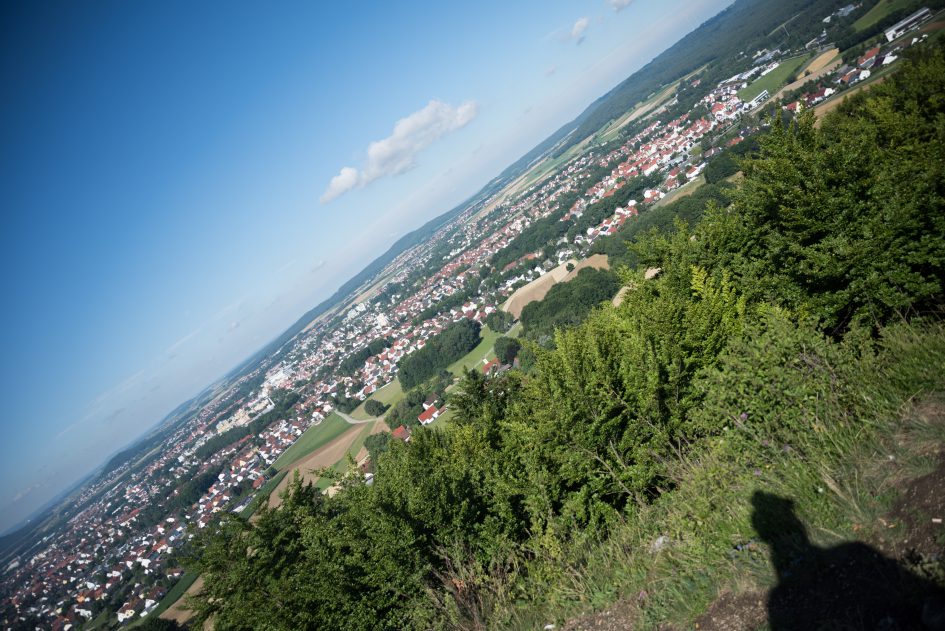
Above: Sigma 24-70/2.8 OS Art at 24mm, f2.8; also available at f4.0, f5.6, f8.0, f11

Above: Sigma 24-70/2.8 OS Art at 24mm, f2.8; 100% crop from center, APS-C/DX-corner, FF/FX-corner

Above: Nikon 24-70/2.8E VR at 24mm, f2.8; 100% crop from center, APS-C/DX-corner, FF/FX-corner
Both lenses are very sharp at the center and a little soft at the APS-C/DX-corner. But the Nikon has a clear advantage in the FF/FX-corner at 24mm.

Above: Sigma 24-70/2.8 OS Art at 24mm, f4.0; 100% crop from center, APS-C/DX-corner, FF/FX-corner

Above: Sigma 24-70/2.8 OS Art at 24mm, f5.6; 100% crop from center, APS-C/DX-corner, FF/FX-corner

Above: Sigma 24-70/2.8 OS Art at 24mm, f8.0; 100% crop from center, APS-C/DX-corner, FF/FX-corner

Above: Sigma 24-70/2.8 OS Art at 24mm, f11; 100% crop from center, APS-C/DX-corner, FF/FX-corner
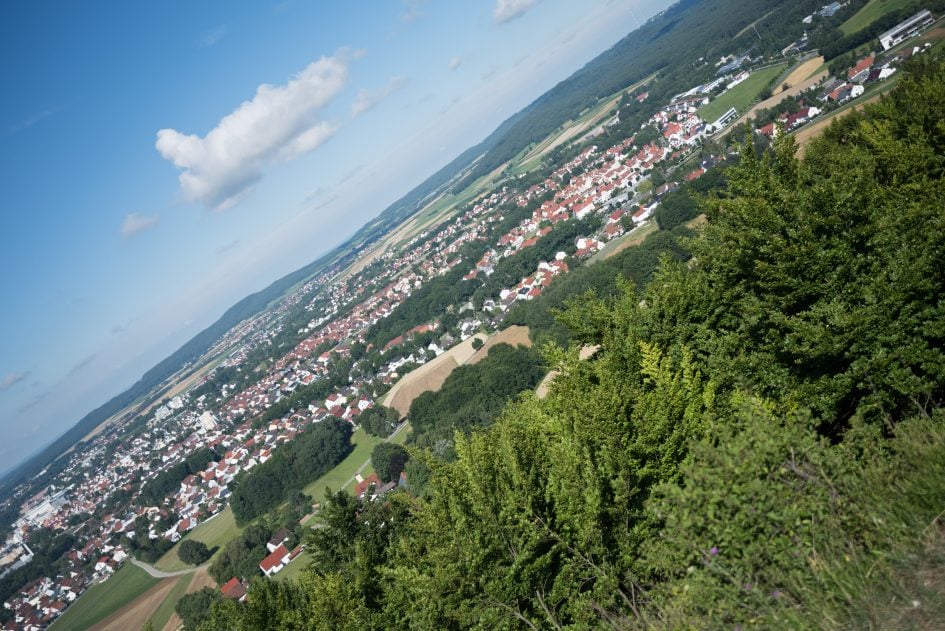
Above: Sigma 24-70/2.8 OS Art at 35mm, f2.8; also available at f4.0, f5.6, f8.0, f11

Above: Sigma 24-70/2.8 OS Art at 35mm, f2.8; 100% crop from center, APS-C/DX-corner, FF/FX-corner

Above: Nikon 24-70/2.8E VR at 35mm, f2.8; 100% crop from center, APS-C/DX-corner, FF/FX-corner
Again, the Nikon is sharper in the FF/FX-corner at 35mm.

Above: Sigma 24-70/2.8 OS Art at 35mm, f4.0; 100% crop from center, APS-C/DX-corner, FX-corner

Above: Sigma 24-70/2.8 OS Art at 35mm, f5.6; 100% crop from center, APS-C/DX-corner, FX-corner

Above: Sigma 24-70/2.8 OS Art at 35mm, f8.0; 100% crop from center, APS-C/DX-corner, FX-corner

Above: Sigma 24-70/2.8 OS Art at 35mm, f11; 100% crop from center, APS-C/DX-corner, FF/FX-corner
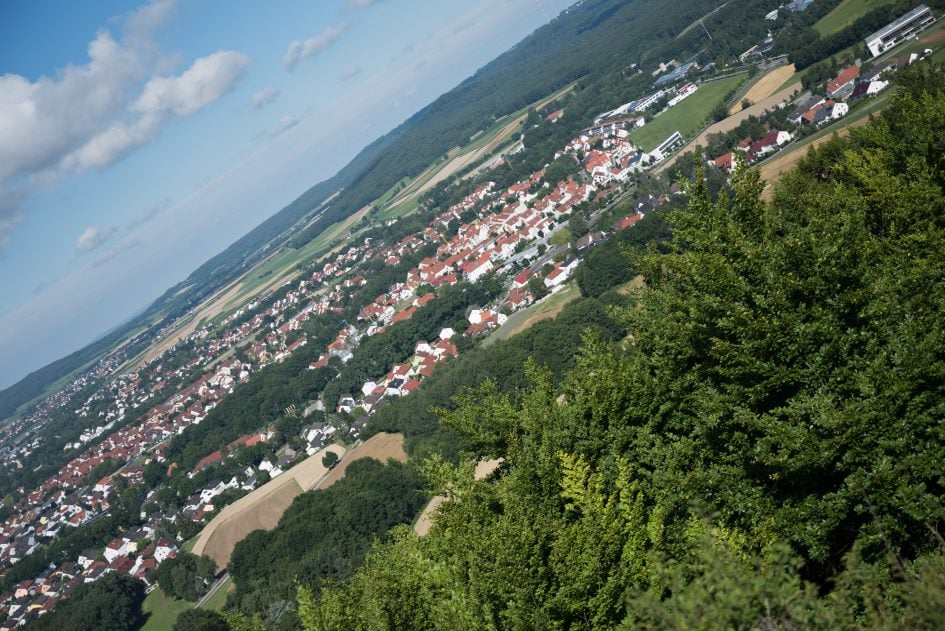
Above: Sigma 24-70/2.8 OS Art at 50mm, f2.8; also available at f4.0, f5.6, f8.0, f11

Above: Sigma 24-70/2.8 OS Art at 50mm, f2.8; 100% crop from center, APS-C/DX-corner, FF/FX-corner

Above: Nikon 24-70/2.8E VR at 50mm, f2.8; 100% crop from center, APS-C/DX-corner, FF/FX-corner
The Sigma seems to have the advantage over the Nikon at the APS-C/DX image circle at 50mm. But the FF/FX-corner of the Nikon is hard to beat.

Above: Sigma 24-70/2.8 OS Art at 50mm, f4.0; 100% crop from center, APS-C/DX-corner, FX-corner

Above: Sigma 24-70/2.8 OS Art at 50mm, f5.6; 100% crop from center, APS-C/DX-corner, FX-corner

Above: Sigma 24-70/2.8 OS Art at 50mm, f8.0; 100% crop from center, APS-C/DX-corner, FF/FX-corner

Above: Sigma 24-70/2.8 OS Art at 50mm, f11; 100% crop from center, APS-C/DX-corner, FF/FX-corner
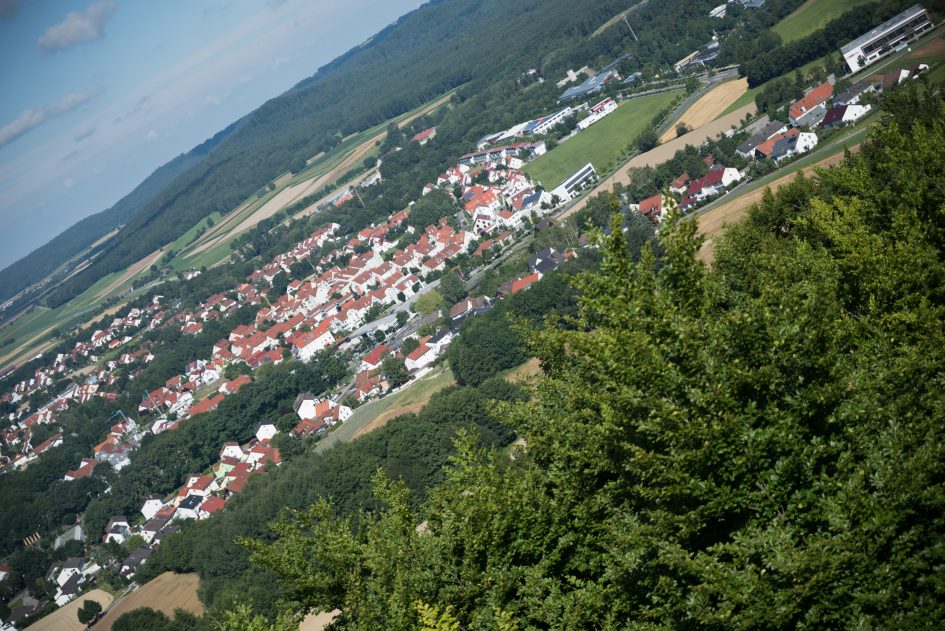
Above: Sigma 24-70/2.8 OS Art at 70mm, f2.8; also available at f4.0, f5.6, f8.0, f11

Above: Sigma 24-70/2.8 OS Art at 70mm, f2.8; 100% crop from center, APS-C/DX-corner, FF/FX-corner

Above: Nikon 24-70/2.8E VR at 70mm, f2.8; 100% crop from center, APS-C/DX-corner, FF/FX-corner
Both lenses look similar in the APS-C/DX image-circle and the Nikon again leads in the FF/FX-corner at 70mm.

Above: Sigma 24-70/2.8 OS Art at 70mm, f4.0; 100% crop from center, APS-C/DX-corner, FX-corner

Above: Sigma 24-70/2.8 OS Art at 70mm, f5.6; 100% crop from center, APS-C/DX-corner, FX-corner

Above: Sigma 24-70/2.8 OS Art at 70mm, f8.0; 100% crop from center, APS-C/DX-corner, FF/FX-corner

Above: Sigma 24-70/2.8 OS Art at 70mm, f11; 100% crop from center, APS-C/DX-corner, FF/FX-corner
In this long distance test the new Sigma produced its best results at 50mm delivering very good sharpness within the APS-C image-circle right from the start and a good FF-corner when stopped down to f5.6. At other focal lengths stopping down to f5.6 also visibly improves the APS-C-corner.
Vignetting
To make it easier to compare light fall-off in the corners of a full-frame sensor I’ve arranged a series of three shots each with the Sigma and the Nikon at different apertures. From left to right: f2.8, f4.0, and f5.6:
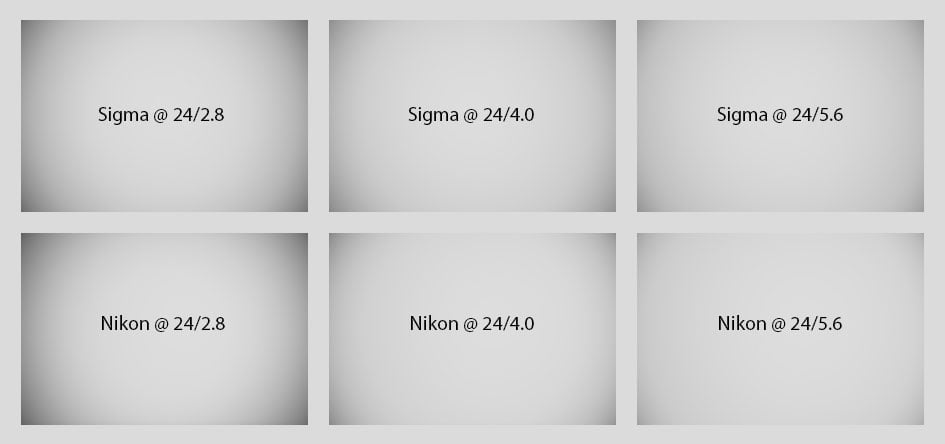
Above: Sigma 24-70mm f2.8 OS Art (1st row) and Nikon 24-70mm f2.8E VR (2nd row) at 24mm
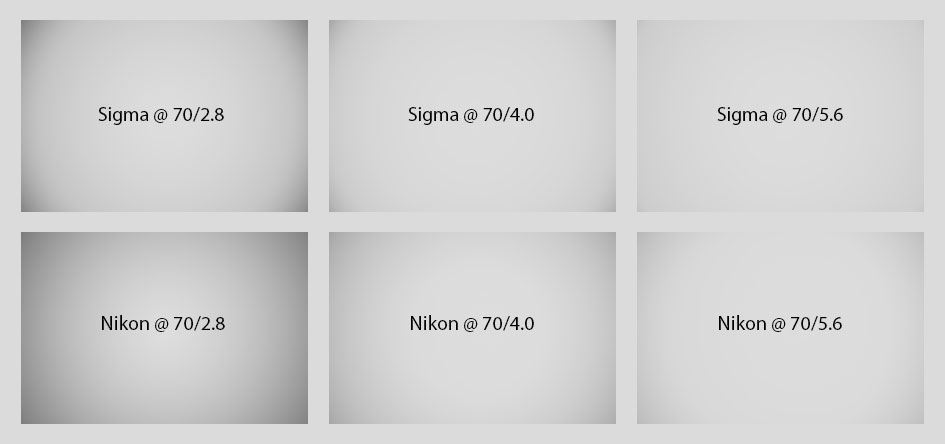
Above: Sigma 24-70mm f2.8 OS Art (1st row) and Nikon 24-70mm f2.8E VR (2nd row) at 70mm
At 24mm the Sigma has slightly less vignetting than the Nikon wide open but stronger light falloff when stopped down. At 70mm focal length the Sigma has consistently less vignetting than the Nikon.
Rendering of point-light sources at night-shots
Night-shots pose a different challenge for lenses as the contrast is even higher than under bright sun and point-light sources can reveal some weaknesses such as coma, haloing and color-aberrations that do not show up as prominently in other test-shots. The 100% crops below the main image show the effect of coma in the FF/FX-corner of the new Sigma and the Nikon 24-70/2.8E VR at various apertures:
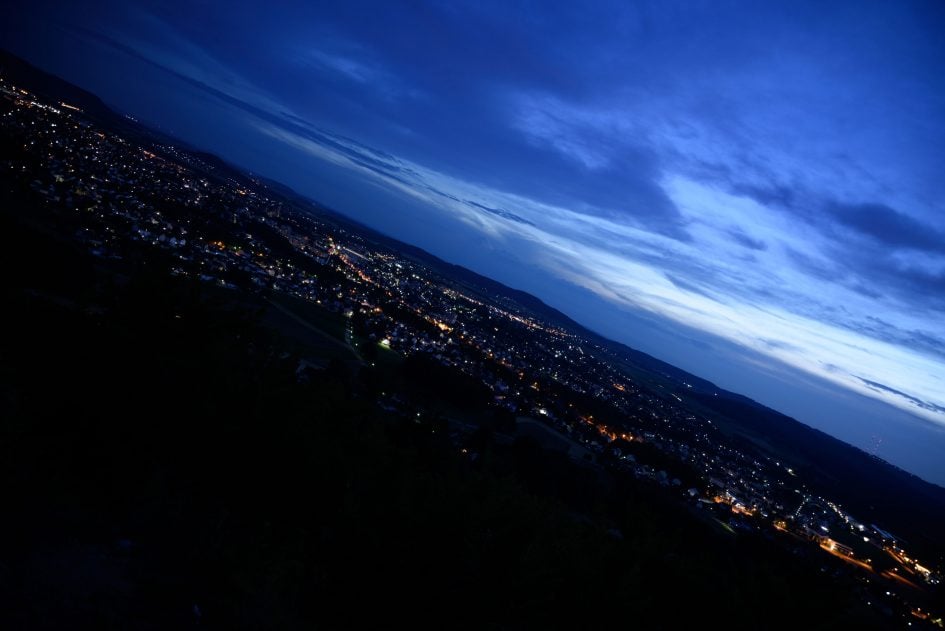
Above: Sigma 24-70mm f2.8 OS Art at 24mm, f2.8; also available at f4.0, f5.6, f8.0

Above: Sigma 24-70mm f2.8 OS Art at 24mm; FF/FX-corner at f2.8 (left), f4.0 (middle), f5.6 (right)

Above: Nikon 24-70mm f2.8E VR at 24mm; FF/FX-corner at f2.8 (left), f4.0 (middle), f5.6 (right)
The coma of the new Sigma is masked by the softness of the lens in the FF/FX-corner. The Nikon in comparison is sharp and shows the typical signatur of coma, albeit a very small one.
Rendering of out-of-focus point-light sources
This test is for the rendering of point-light sources in an out-of-focus background. The circle of confusion that is produced by this test is pretty indicative of Bokeh performance (in the background) and light fall-off. Ideally the out-of-focus image of the point-light is evenly lit and perfectly circular, with no “onion-rings”, and without coloration. Large aperture lenses normally produce an effect known as “cat’s eye” the further away from the optical axis the point-light is projected. This is due to optical vignetting in the lens barrel when light enters the lens from an angle.
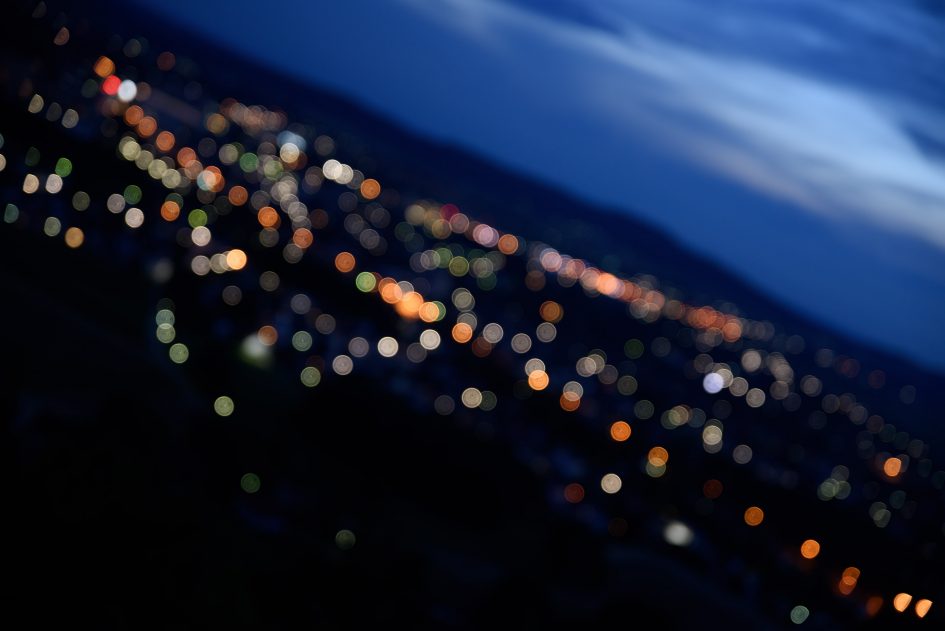
Above: Sigma 24-70mm f2.8 OS Art on a D810 at 70mm, f2.8; also available at f4.0, f5.6, f8.0

Above: Sigma 24-70mm f2.8 OS Art at 70mm, f2.8; 50% crops from center, DX-corner, FX-corner
And compared to the Nikon 24-70/2.8E VR:

Above: Nikon 24-70mm f2.8E VR at 70mm, f2.8; 50% crops from center, DX-corner, FX-corner; Also available at f4.0, f5.6, f8.0
The 50% crops above show: The Sigma 24-70/2.8 OS Art produces a bright outline and an uneven light distribution across the circle of confusion. There are also some weak onion rings from its aspherical elements. The compression of the Bokeh balls towards the borders is not as strong as with the Nikon – an indicator that the Nikon has the stronger light fall-off in the corners. There is no clipping from the mirror-box.
Now let’s see how this analysis of out-of-focus point-light sources translates into Bokeh-performance shooting a book-shelf.
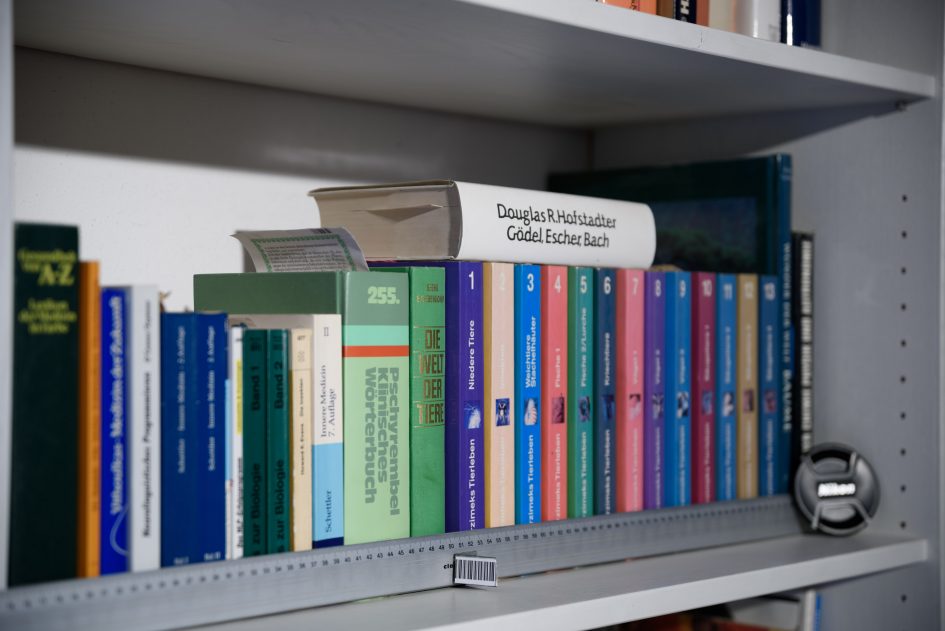
Above: Sigma 24-70mm f2.8 OS Art on a D810 at 70mm, f2.8; also available at f4.0, f5.6, f8.0

Above: Sigma 24-70mm f2.8 OS Art at 70mm, f2.8; 50% crops from foreground, middle-ground, background

Above: Nikon 24-70mm f2.8E VR at 70mm, f2.8; 50% crops from foreground, middle-ground, background; also available at f4.0, f5.6, f8.0
The middle-ground of the Sigma shows a smooth transition without coloration but the background is a bit nervous – although not badly so. The (less important) foreground looks OK. In comparison the Nikon shows more coloration in the middle-ground, a less blurred foreground and a more nervous background. So this is a clear win for the Sigma.
Flare, ghosting, and sun-stars
Catching a strong light-source shining directly into the lens is always a risky business. It could produce strange colorful ghost-images or reduce contrast considerably through flare and glare. The appearance of flare and ghosting depends on factors like the aperture and the angle of the light hitting the lens. So to judge the proclivity of the new Sigma for these artifacts I went through a series of well calculated shots against a strong light source to provoke glare and ghosting. The lens hood was attached in all of these tests.
The new Sigma does produce quite some flare and ghosting when the light-source is inside the frame with the strongest effects occurring at the long end. You can also see that the sun-stars are not very well defined at f8 and 70mm focal length:
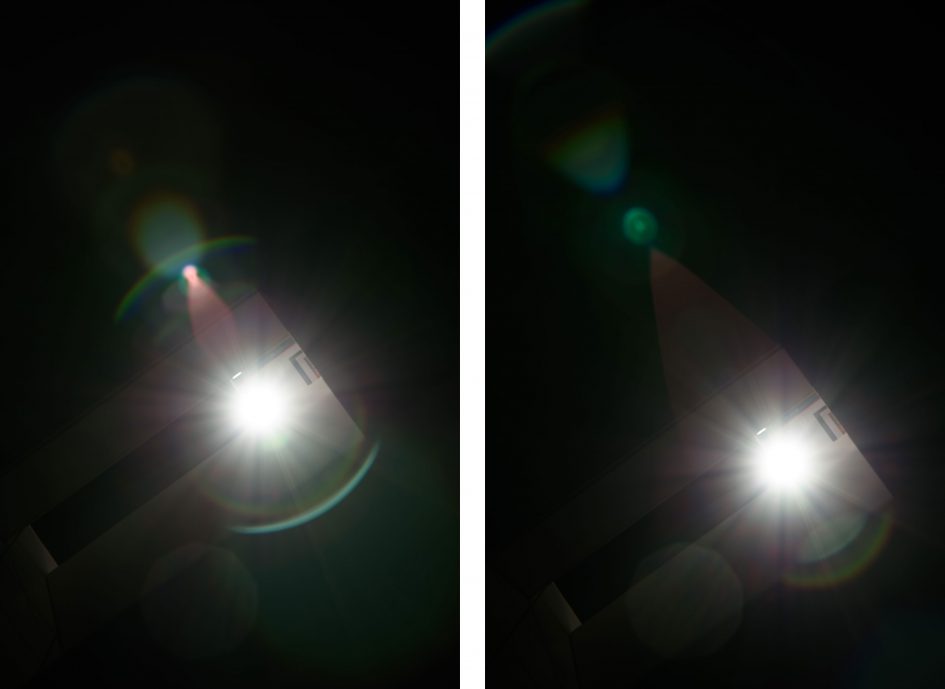
Above: Flare and ghosting. Strong light hitting the Sigma 24-70mm f2.8 OS Art at 70mm, f8.0
On the short end the lens behaves less critical and produces much nicer sun-stars. Still it shows some flares and ghosts when the light is inside the frame and a very visible halo when the light is dead center:
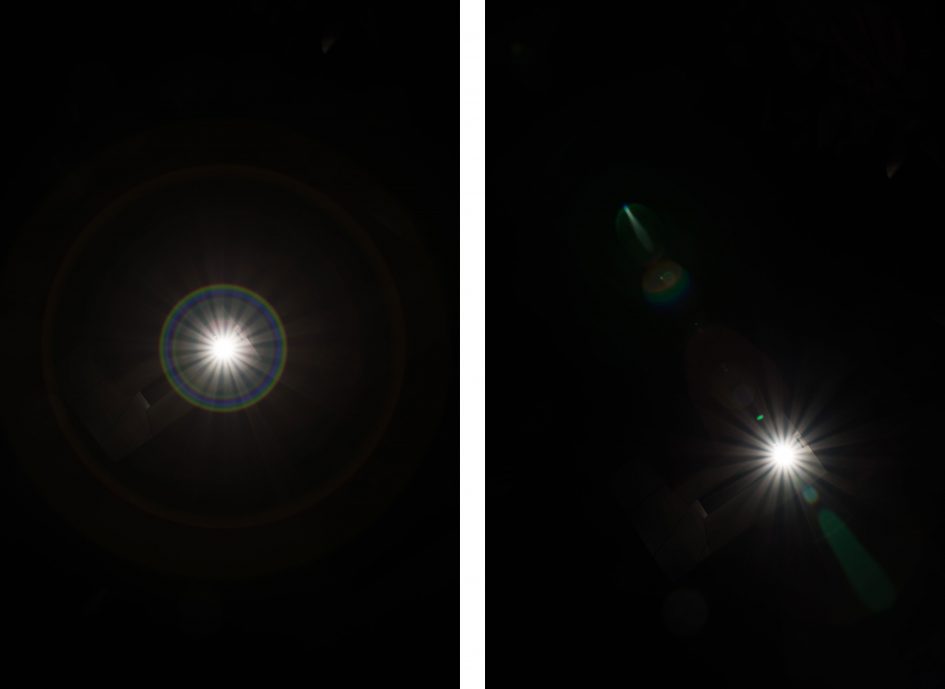
Above: Flare and ghosting. Strong light hitting the Sigma 24-70mm f2.8 OS Art at 24mm, f8.0
By comparison the Nikon 24-70mm f2.8E VR is less prone to these effects. But the good news is: Outside these artifacts the new Sigma renders a deep black and when the light-source is outside the FF/FX-frame (but still shining into the lens) it produces no flares or ghosts.
Next check out my sample images!




